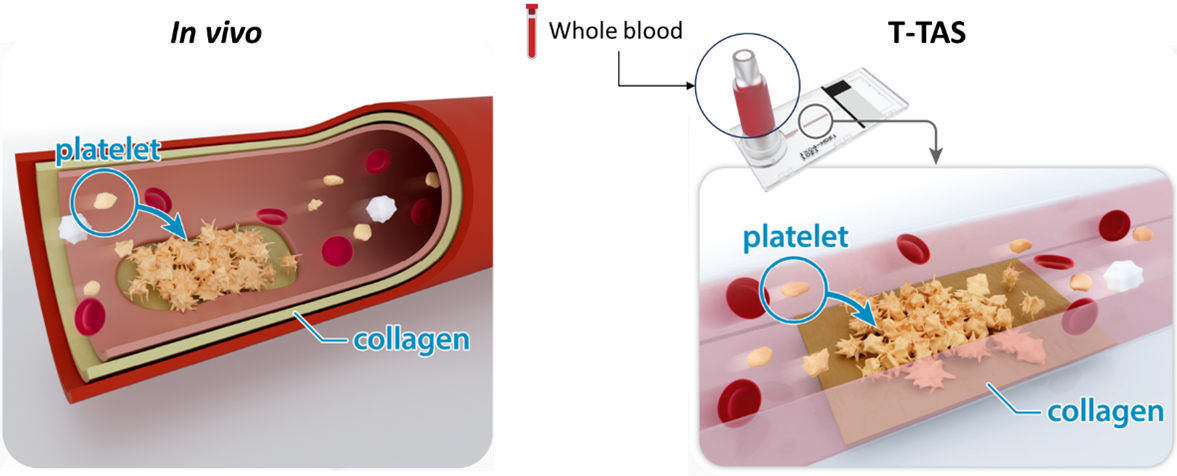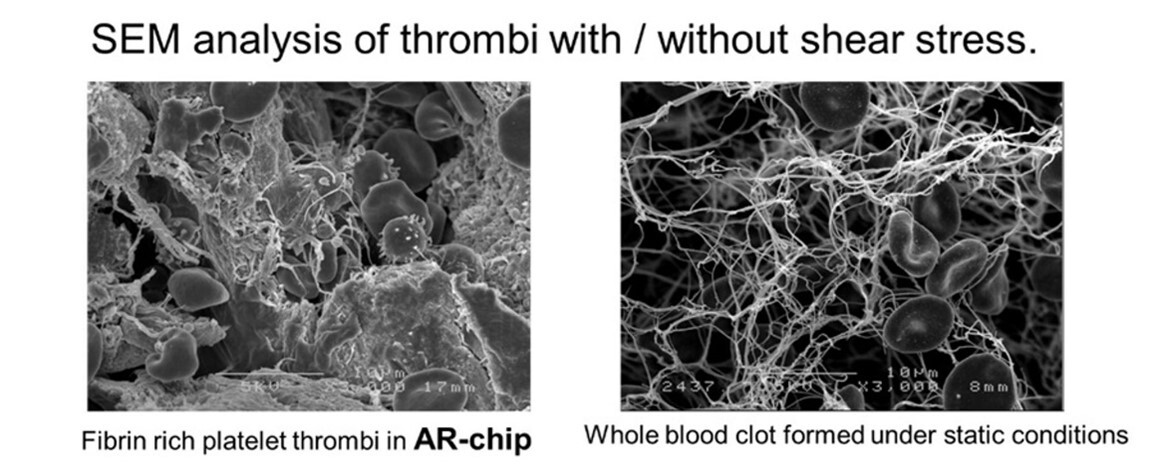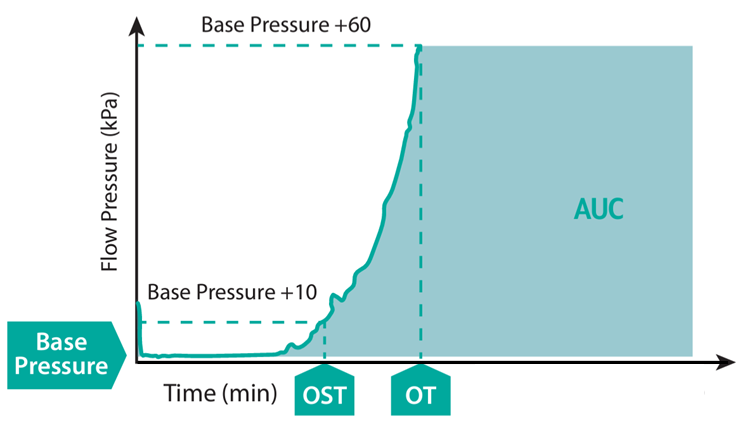T-TAS®︎ System
T-TAS assay principle
The T-TAS (Total Thrombus formation Analysis System) system and dedicated microchips were designed to simulate the response to blood vessel injury for ex vivo measurement of the thrombus formation process. When blood vessels are injured, platelets bind to exposed collagen under arterial flow conditions in a von Willebrand-factor dependent manner. The flow paths of the T-TAS microchips are coated with a thrombogenic surface, either collagen or collagen and tissue thromboplastin, which imitates the thrombogenic environment of damaged blood vessels.
The T-TAS system is a small tabletop device with a built-in pump and pressure sensor. The pump uses mineral oil to push the blood sample into the chip at a constant flow rate and across the thrombogenic surface to initiate thrombus formation.
When a thrombus is forming within the flow path, the flow becomes restricted, resulting in an increased flow pressure inside the chip.
The use of mineral oil in the T-TAS instrument is advantageous because unlike air, mineral oil has low compressibility, which makes pressure changes measured by the T-TAS instrument more specific for thrombus formation occurring within the chip.

Thrombus formation under the blood flow
Blood flows continuously through blood vessels, and the hemostatic response in vivo begins and progresses under blood flow conditions.
Because platelets are activated by shear stress caused by blood flow, thrombus formation under blood flow conditions contain numerous activated platelets, which thrombus formation under static conditions do not.
Most common platelet function tests and coagulation tests are performed in the absence of blood flow conditions. While these tests provide information about specific components of platelet function, they do not provide a complete analysis of the thrombus formation process. Because the T-TAS assays are performed under arterial flow conditions, thrombus formation occurs in a platelet-dominant manner, as thrombus formation is driven by von Willebrand-dependent platelet adhesion to the thrombogenic surface.

Measured result
The pressure within the flow path is monitored over time by the pressure sensor, and it is possible to quantitatively observe how the growing thrombus affects the flow pressure inside the chip.
There are three result parameters that are automatically generated by the T-TAS instrument.
-
OST: Occlusion start time, The time when the pressure reaches 10 kPa above the baseline pressure (measured at the start of the assay).
-
OT: Occlusion time, The time when the pressure reaches 60 kPa above the baseline pressure.
-
AUC: The area under the pressure-time curve.
A prolonged OST and/or OT, as well as a decreased AUC is associated with impaired thrombogenicity.
For example, in the T-TAS PL assay, an AUC result less than 260 suggests that primary hemostasis (e.g., platelet function) is impaired.

PL Assay
PL assay principle
The T-TAS® PL assay measures the platelet thrombus formation process (primary hemostasis) in whole blood under physiological flow conditions. The assay is performed by moving BAPA-anticoagulated whole blood under arterial flow conditions across a collagen coated thrombogenic surface, which mimics exposed collagen at the site of vessel injury. Under arterial flow conditions, platelet adhesion to collagen is dependent on the action of von-Willebrand factor (vWF). Following vWF -mediated platelet adhesion to the collagen-coated surface, the platelets become activated, and the release reaction occurs, which involves the release of endogenous platelet activators (agonists) from the activated platelets. These endogenous agonists recruit and activate other platelets in the blood sample to produce platelet aggregation, resulting in a growing platelet thrombus inside the PL chip. Unlike other platelet assays, the blood sample is exposed to physiological flow conditions and there are no exogenous soluble agonists in the PL assay, making the test sensitive to abnormalities in the platelet thrombus formation process.
BAPA anticoagualnt
BAPA (benzylsulfonyl-d-arg-pro-4 amidinobenzylamide) is an anticoagulant that inhibits coagulation factors Xa and IIa (thrombin) and completely suppresses coagulation activation while maintaining physiological calcium levels. Venous whole blood is collected into evaluated BAPA blood collection tubes containing spray-coated BAPA anticoagulant. Because coagulation activation is completely suppressed, the use of BAPA-anticoagulated whole blood makes the PL assay highly specific for only the platelet thrombus formation process (primary hemostasis). Because physiological calcium levels are maintained, the PL assay does not require additional exogenous reagents to produce platelet activation and thrombus formation.
AR and HD Assay
AR assay principle
The T-TAS® AR and HD assays are designed to measure the thrombus formation process (thrombogenicity) caused by the combined effects of the platelet activation and blood coagulation systems (both primary and secondary hemostasis) under physiological flow conditions. The assay is performed by moving pre-treated 3.2 % sodium citrate-anticoagulated whole blood under arterial flow conditions across a thrombogenic surface consisting of collagen and tissue thromboplastin, which mimics the site of vessel injury. When whole blood passes across the thrombogenic surface at arterial flow rates, platelet adhesion occurs in a von-Willebrand factor-dependent manner, followed by platelet activation and aggregation. The coagulation cascade is activated through contact with the surface of activated platelets and tissue thromboplastin on the thrombogenic surface. Unlike assays that measure only platelet function or coagulation activity, the activation of both platelets and the coagulation cascade in the AR/HD assay produces a fibrin-rich platelet thrombus, which reflects the potential for thrombus formation (thrombogenicity) in a platelet-dominant manner. The HD assay is the first assay that measures thrombogenicity in whole blood samples with low platelet count.
CaCTI reagent
The CaCTI reagent is a mixture of calcium (Ca) and corn trypsin inhibitor (CTI). The AR/HD assays measure thrombogenicity in a 3.2 % sodium citrate-anticoagulated whole blood sample. Sodium citrate exerts its anticoagulant effects by chelating calcium in the whole blood sample. To measure the thrombus formation process, it is necessary to add calcium to the whole blood sample to facilitate activation of the coagulation pathway. The CaCTI reagent is added immediately prior to starting the AR/HD measurement, to restore the calcium concentration and reactivate the coagulation system in the sample. Adding calcium to the whole blood sample may trigger activation of the intrinsic blood coagulation pathway, causing blood to clot before it reaches the thrombogenic surface inside the AR/HD chip. To avoid activation of the intrinsic coagulation pathway, the CaCTI reagent also contains corn trypsin inhibitor (CTI), which inhibits coagulation factor XIIa and prevents activation of the intrinsic coagulation pathway. Because the intrinsic coagulation pathway is inhibited, coagulation occurs via the extrinsic coagulation pathway when the blood sample is in contact with the thrombogenic path. The CaCTI reagent contains Ca and CTI at optimal concentrations for the AR/HD assays.
Anti-Sedimentation Reagent
Erythrocytes are negatively charged, and electrostatic repulsion usually prevents significant blood cell sedimentation. However, inflammatory disorders and low blood cell counts may cause blood cell sedimentation. Because the AR/HD assay measurement takes up to 30 minutes, there is a possibility that erythrocyte sedimentation may occur within the measurement time, which may affect the measurement results. The Anti-sedimentation Reagent contains negatively charged DNDS (Disodium 4, 4'-Dinitrostilbene-2,2'-disulfonate) that inhibits erythrocyte sedimentation when added to a whole blood sample.

